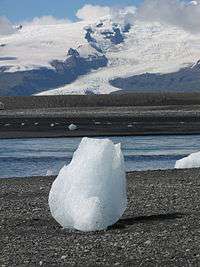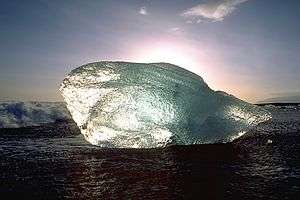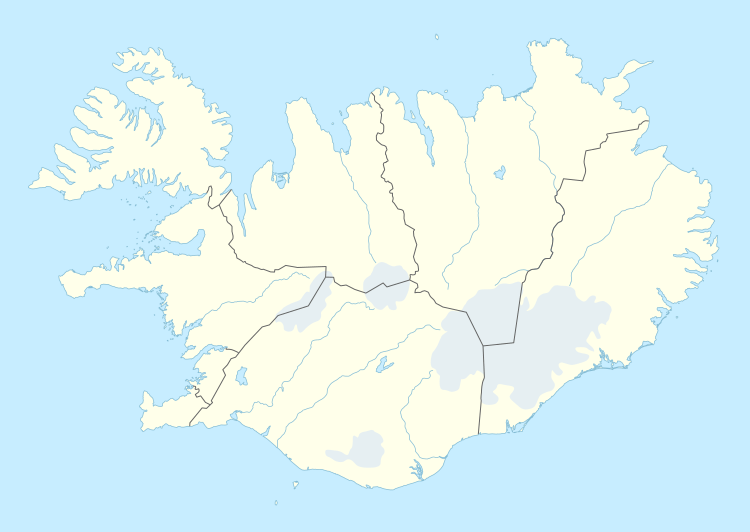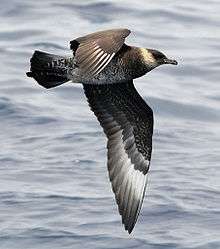Jökulsárlón
| Jökulsárlón | |
|---|---|
 | |
| Coordinates | 64°04′13″N 16°12′42″W / 64.07028°N 16.21167°WCoordinates: 64°04′13″N 16°12′42″W / 64.07028°N 16.21167°W |
| Type | Glacial |
| Primary inflows | Breiðamerkurjökull glacier |
| Primary outflows | Atlantic Ocean |
| Basin countries | Iceland |
| Max. length | 1.5 km (0.93 mi) |
| Surface area | 18 km2 (6.9 sq mi) |
| Max. depth | 248 metres (814 ft) |
| Water volume | 2,500–3,000 hm3/s (0.60–0.72 cu mi/s) |
| Surface elevation | 0 m (0 ft), sea level |
Jökulsárlón (Icelandic pronunciation: [ˈjœːkʏlsˌaurˌloun̥] (![]()
The lake can be seen from Route 1 between Höfn and Skaftafell. It appears as "a ghostly procession of luminous blue icebergs".[3]
Jökulsárlón has been a setting for four Hollywood movies: A View to a Kill, Die Another Day, Lara Croft: Tomb Raider, and Batman Begins, as well as the reality TV series Amazing Race.[3][7] In 1991, Iceland issued a postage stamp, with a face value of 26 kronur, depicting Jökulsárlón.[2]
The tongue of the Breiðamerkurjökull glacier is a major attraction for tourists.
History

The first settlers arrived in Iceland around AD 870, when the edge of the tongue of Breiðamerkurjökull glacier was about 20 km (12 mi) further north of its present location. During the Little Ice Age between 1600 and 1900, with lower temperatures prevailing in these latitudes, the glacier had grown by up to about 1 km (0.62 mi) from the coast at Jokulsá River, by about 1890. When the temperatures rose between 1920 and 1965, the Breiðamerkurjökull glacier tongue rapidly retreated, continually creating icebergs of varying size, thus creating a lagoon in its wake around 1934–35. The lake is about 200 m (660 ft) deep where the glacier snout originally existed. Glacial moraines became exposed on both sides of the lake. In 1975, the lake was about 8 km2 (3.1 sq mi) in area and now it reportedly stands at 18 km2 (6.9 sq mi) at the edge of the glacier tongue.[4]
Geography

The Jökulsárlón lake provides outstanding views of the ice cap, a vast dome of ice that rises to a height of 3,000 ft (910 m). It spills to the lagoon 12 mi (19 km) away from the jagged glacier hill to the edge of the water line. The lake developed only about 60 years ago (1948 is mentioned), when the entire area was less than 100 ft (30 m) of glacier, which was only 250 yd (230 m) from the Atlantic Ocean, and 2 mi (3.2 km) away from Vatnajökull. Vatnajökull was at the shore line of the ocean and dropped icebergs into the ocean. However, it started drifting inland rapidly every year, leaving deep gorges en route, which got filled with melted water and large chunks of ice. These icebergs gather at the mouth of the lake's shallow exit, melt down into smaller ice blocks, and roll out into the sea. In summer, icebergs melt and roll down the channel into the sea. The lake does not freeze in winter. Ice water and soil make a unique ecological phenomenon. Jökulsárlón Lake, the "glacier lake", is now reported to have doubled in size in the recent 15-year period. The huge blocks of ice that calve from the edge of Vatnajökull are about 30 m (98 ft) high, which fills the lagoon stocked with icebergs.[5][8][9][10] Some icebergs appear naturally sculpted on account volcanic ash from ancient eruptions that partly covers them.[11]


Given the current retreat rate of Vatnajökull, likely a deep fjord will develop where Jökulsárlón is now. This retreat is also posing a threat to the National Highway Route 1 of Iceland. The lagoon is 75 km (47 mi) to the west of Höfn town and 60 km (37 mi) east of Skaftafell.[9][12] It is accessible by the ring road, Route 1, that goes across the lake, and where parking facilities have been provided for visitors. It is also known as the "tourist conveyor belt". While walking on the shore, isolated large blocks of icebergs can be seen on the black sand beach.[5]
Protective measures for the bridge
A coffer dam was constructed near the Glacial River Bridge that spans Jökulsárlón to build a row of protective measures of stone boulders to prevent any erosion of the foundation of the pillars of the bridge. This coffer dam enabled the Icelandic road administration to create workable access for the power shovel digger to place the row of stone protective measures, which would also divert the icebergs from hitting the bridge pillars, thus avoiding damage to the structure.[13]

Features
The icebergs that calve from the glacier edge move towards the river mouth and get entrenched at the bottom. The movement of the icebergs fluctuates with the tide currents, as well as being affected by wind. However, they start floating as icebergs when their size is small enough to drift to the sea. These icebergs are seen in two shades: milky white and bright blue, which depends on the air trapped within the ice and is an interplay of light and ice crystals.[14]
Fauna

The lake is filled with fish that drift in from the sea along with the tides. Seals gather in large numbers at the mouth of the lake to catch fish during the winter. Large numbers of seabirds, particularly Arctic terns, which nest nearby, gather to catch herring, trout, salmon, krill and other fish. Breiðamerkursandur (the large sand deposits in the area) is the main habitat of the skua (Stercorariidae).[5][11] During the summer season, the gull-like skuas have their nests on the lake's shores. The skuas, fat and dark in colour with white wings, are said to be aggressive "pirates of the seas", which harass other birds as big as gannets. They also kill and eat smaller birds such as puffins. Gannets are not afraid of human beings and also do not tolerate human beings close to their nests. These birds are reported to migrate from their wintering grounds off the coasts of Spain and Africa. Seals are seen either swimming in the lagoon or lying on icebergs. Many times, the tides carry shoals of herring or capelan into the lagoon by the tide and the birds feast on them.[14]
Ownership
The Jökulsárlón Landowners Association represents the owners of the land property Fell, which covers the Jökulsárlón, also known as the Glacier Lake. This property is leased out for filming or any other commercial activity as required.[15]
Einar Björn Einarsson is the operator of the boat trips on the Glacier Lagoon. The Landowners Association leases out the site at the lagoon front to this operator to ply the boats on the lagoon.[15]
Boat tours on the glacier lake
In 1985, the premiere of the James Bond movie A View to a Kill marked the start of commercial boat tours on the lake. Guðbrandur Jóhannesson started the tours on Jökulsárlón. Jóhannesson, who today owns and operates the company Vatnajökull Travel, operated the tours for the first two years. In summer 1987, about 5,000 passengers sailed on the company's two small vessels. The next year, an amphibious vehicle, the LARC-V, joined the fleet. By 1995, the number of passengers per year had multiplied and the company then operated three amphibious vehicles. In 1999, Einar Björn Einarsson, a local from the nearby town of Höfn, bought the company. In 2006, the company added a fourth amphibian.
The company Jökulsárlón ehf now employs about 30 seasonal employees. For the past few years, the company has carried 60,000 to 70,000 passengers annually; since the first commercial boat tour, about 900,000 tourists have taken the excursion.
In popular culture
Jökulsárlón and the Breiðamerkurjökull glacier have been part of the James Bond films A View to a Kill (1985) and Die Another Day (2002), Batman Begins (2005),[3] Beowulf and Grendel (2005), and Lara Croft: Tomb Raider [4][11]
The popularity of the lake has been further boosted by the TV coverage provided live from Jökulsárlón on the American TV program Good Morning America in southeast Iceland, on 13 November 2006. The live broadcast is reported to have been watched by four million people.[16]
In 2014, Swedish electronic multimedia project, iamamiwhoami, filmed their music video "vista" in Jökulsárlón.
See also
References
- ↑ "Jökulsárlón become the country's deepest lake". Visir. Retrieved 2012-01-04.
- 1 2 "Jökulsárlón". Virtually Virtual Iceland. Retrieved 2010-10-13.
- 1 2 3 4 Stone, Andrew (2009). Scandinavian Europe. Lonely Planet. p. 268. ISBN 1-74104-928-8. Retrieved 2010-10-13.
- 1 2 3 "Jokulsarlon Glacier Lagoon". Iceland on the web. Retrieved 2010-10-13.
- 1 2 3 4 Evans, Andrew (2008). Iceland. Bradt Travel Guides. p. 389. ISBN 1-84162-215-X.
- ↑ Gunnarsdottir, Nanna. "Jokulsarlon - The crown jewel of Iceland's nature". Guide to Iceland.
- ↑ "Jökulsárlón". Nordic Visitor Iceland. Retrieved 2010-10-13.
- ↑ "Popular attraction". Landowners Association. Retrieved 2010-10-13.
- 1 2 Woodard, Colin (2009). Issues for Debate in Environmental Management: Selections from CQ Researcher by CQ Researcher. Curbing Climate Change. SAGE. pp. 25–26. ISBN 1-4129-7877-7. Retrieved 2010-10-13.
- ↑ "Formation of the Glacier Lagoon". The Icebergs and jökulsá river formed the Jökulsárlón, Glacial Lagoon. Landowners Association. Retrieved 2010-10-13.
- 1 2 3 "South Coast and Jokulsarlon glacier lagoon". Nordic Visitor day Tour in Iceland. Retrieved 2010-10-13.
- ↑ "Glacier lagoon: Unique iceberg lagoon". The Vatnajokull Region Wow South East Of Iceland. Archived from the original on 2014-02-22. Retrieved 2010-10-13.
- ↑ "Building of a dam on Jökulsarlon in June 2010". Jökulsarlon Landowners Association. Retrieved 2010-10-14.
- 1 2 "A unique pearl of nature". Landowners Association. Retrieved 2010-10-13.
- 1 2 "The Jokulsarlon Landowners Association". Landowners Association. Retrieved 2010-10-13.
- ↑ "Good Morning America live in Iceland". Iceland Review Online. 2006-11-14. Retrieved 2010-10-13.
External links
| Wikimedia Commons has media related to Jökulsárlón. |
| Wikivoyage has a travel guide for Jökulsárlón. |

